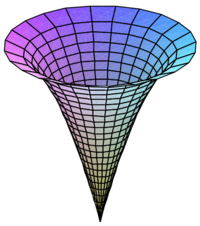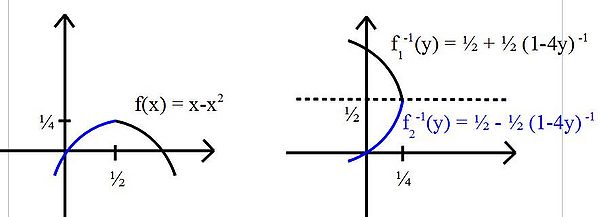Science:Math Exam Resources/Courses/MATH103/April 2010/Question 08
{{#incat:MER QGQ flag|{{#incat:MER QGH flag|{{#incat:MER QGS flag|}}}}}}
• Q1 (a) • Q1 (b) • Q1 (c) • Q1 (d) • Q1 (e) • Q1 (f) • Q1 (g) • Q1 (h) • Q2 • Q3 (a) • Q3 (b) • Q4 (a) • Q4 (b) • Q4 (c) • Q5 (a) • Q5 (b) • Q6 (a) • Q6 (b) • Q7 (a) • Q7 (b) • Q7 (c) • Q8 •
Question 08 |
|---|
|
The graph of the function is rotated about the y axis to form a trumpet shape whose base is at (0,0). Determine the volume of fluid that can be contained inside this shape. |
|
Make sure you understand the problem fully: What is the question asking you to do? Are there specific conditions or constraints that you should take note of? How will you know if your answer is correct from your work only? Can you rephrase the question in your own words in a way that makes sense to you? |
|
If you are stuck, check the hints below. Read the first one and consider it for a while. Does it give you a new idea on how to approach the problem? If so, try it! If after a while you are still stuck, go for the next hint. |
Hint 1 |
|---|
|
(Note: This hint was given on the exam question itself.) One way to solve this problem is to find the function that describes the same curve and use it to set up the appropriate integral.) |
Hint 2 |
|---|
|
The formula for the disc method, for a function y = f(x) rotated about the y-axis, is |
Hint 3 |
|---|
|
The formula for the shell method, for a function y = f(x) rotated about the y-axis, is where h(x) is the height of the shell at x. |
|
Checking a solution serves two purposes: helping you if, after having used all the hints, you still are stuck on the problem; or if you have solved the problem and would like to check your work.
|
Solution 1 |
|---|
|
We want to use the disk method and so we need to take the inverse of the function We get two possible inverse functions and On the picture we see that for our purpose we need the function . To find the boundaries for the integral we calculate Now we use the formula for the disk method . Here is the volume and is the function of the radius. We need the function for the radius. |
Solution 2 |
|---|
|
For this problem it is much easier to use the shell method. For using the shell method we need to know the height of the trumpet for every This is Now we can easily integrate |
{{#incat:MER CT flag||
}}

















![{\displaystyle {\begin{aligned}V&=\int _{0}^{\frac {1}{4}}\pi \left({\frac {1}{2}}-{\frac {\sqrt {1-4y}}{2}}\right)^{2}\,dy\\&=\pi \int _{0}^{\frac {1}{4}}\left({\frac {1}{4}}-{\frac {1}{2}}{\sqrt {1-4y}}+{\frac {1-4y}{4}}\right)\,dy\\&=\pi \int _{0}^{\frac {1}{4}}\left({\frac {1}{2}}-{\frac {1}{2}}{\sqrt {1-4y}}-y\right)\,dy\\&={\frac {\pi }{2}}\int _{0}^{\frac {1}{4}}\left(1-(1-4y)^{\frac {1}{2}}-2y\right)\,dy\\&={\frac {\pi }{2}}\left[y-{\frac {2}{3}}(1-4y)^{\frac {3}{2}}\left(-{\frac {1}{4}}\right)-y^{2}\right]_{0}^{\frac {1}{4}}\\&={\frac {\pi }{2}}\left({\frac {1}{4}}+{\frac {1}{6}}\left(1-4(1/4)\right)^{\frac {3}{2}}-(1/4)^{2}-0-{\frac {1}{6}}(1-4(0))^{\frac {3}{2}}+0^{2}\right)\\&={\frac {\pi }{2}}\left({\frac {1}{4}}-{\frac {1}{16}}-{\frac {1}{6}}\right)\\&={\frac {\pi }{96}}\end{aligned}}}](https://wiki.ubc.ca/api/rest_v1/media/math/render/svg/e18d39131cd6034be8b4a6c51084d354e31bf22a)

![{\displaystyle \ x\in [0,{\frac {1}{2}}].}](https://wiki.ubc.ca/api/rest_v1/media/math/render/svg/0e1c9adf975890a0fffbd3f8bb5fddb121e7378d)

![{\displaystyle {\begin{aligned}V&=\int _{0}^{\frac {1}{2}}2\pi xh(x)dx\\&=2\pi \int _{0}^{\frac {1}{2}}x\left({\frac {1}{4}}-x+x^{2}\right)dx\\&=2\pi \left[{\frac {1}{4}}{\frac {x^{2}}{2}}-{\frac {x^{3}}{3}}+{\frac {x^{4}}{4}}\right]_{0}^{\frac {1}{2}}\\&=2\pi \left[{\frac {1}{4}}{\frac {1}{8}}-{\frac {1}{8}}{\frac {1}{3}}+{\frac {1}{16}}{\frac {1}{4}}-0\right]\\&={\frac {\pi }{96}}\end{aligned}}}](https://wiki.ubc.ca/api/rest_v1/media/math/render/svg/5d4fecb601f41ceb48bf14626fdc725c57583f0c)
